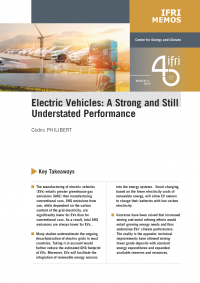
Electric Vehicles: A Strong and Still Understated Performance Ifri Memos, Ifri, March 2024
Electric vehicles (EVs) are better for the climate – even in worst-case scenarios. Across its life cycle, a typical European electric car produces less greenhouse gas (GHG) and air pollutants or noise than its petrol or diesel equivalent. Emissions are usually higher in the production phase, but these are more than offset over time by lower emissions in the use phase. According to the European Environment Agency’s report on electric vehicles, life cycle GHG emissions of EVs are about 17-30% lower than those of petrol and diesel cars.

More specifically, the manufacture of EVs results in higher carbon dioxide (CO2) emissions than in the case of classical internal combustion engine (ICE) cars. This is due mainly to the extraction and refining of the metals–often with high-temperature heat–that enter the composition of batteries: “Building the 80 kilowatt-hour (kWh) lithium-ion battery found in a Tesla Model 3 creates between 2.5 and 16 metric tons of CO2–exactly how much depends greatly on what energy source is used to do the heating”, according to the Massachusetts Institute of Technology, summarizing a range of different studies.
Then, EVs enable CO2 emission savings by not burning petroleum products and using only grid electricity for propulsion. Hence, the actual CO2 savings depend on the carbon content of that electricity. In Norway, where the electricity comes almost 100% from hydropower, EVs have a very low carbon footprint over their life cycle. In countries where the electricity comes almost exclusively from coal plants, the climate advantage of electric cars is indeed small. But one must make rather unrealistic assumptions of a very short distance traveled by a car over its technical life to show greater emissions from an EV compared to its “thermal” counterpart.
While some think tanks do so to defend the oil business, all serious analyses acknowledge at least some better climate performance of EVs over ICE vehicles. According to the Agency for Energy Transition (ADEME), an electric car has a carbon footprint two to three times lower than a similar thermal car, provided it is equipped with a “reasonably sized battery providing up to 450 kilometers range (WLTP)
- The manufacturing of electric vehicles (EVs) entails greater greenhouse gas emissions (GHG) than manufacturing conventional cars. GHG emissions from use, while dependent on the carbon content of the grid electricity, are significantly lower for EVs than for conventional cars. As a result, total GHG emissions are always lower for EVs.
- Many studies underestimate the ongoing decarbonization of electric grids in most countries. Taking it in account would further reduce the estimated GHG footprint of EVs. Moreover, EVs will facilitate the integration of renewable energy sources into the energy systems. Smart charging, based on the lower electricity costs of renewable energy, will allow EV owners to charge their batteries with low carbon electricity.
- Concerns have been raised that increased mining and metal refining efforts would entail growing energy needs and thus undermine EVs’ climate performance. The reality is the opposite: technical improvements have allowed mining lower grade deposits with constant energy expenditures and expanded available reserves and resources.


